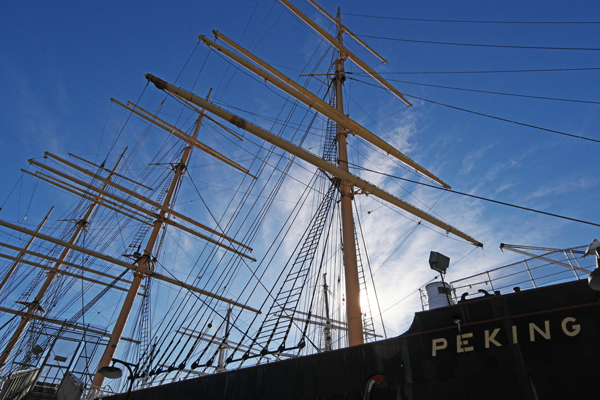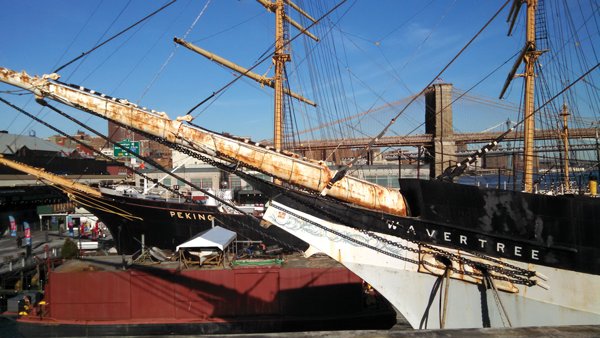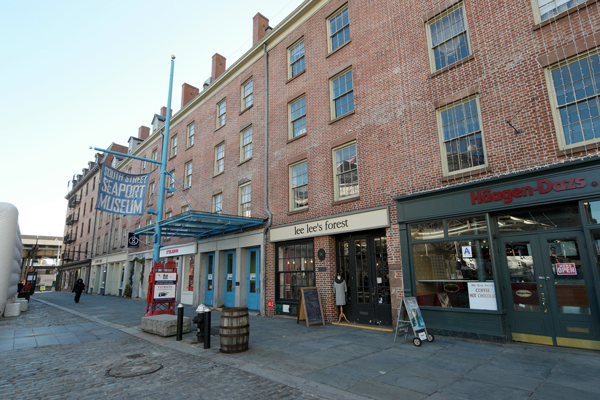
The South Street Seaport Museum appears to be moving toward finding a new home for the Peking.
BY JOSH ROGERS | The cash-strapped South Street Seaport Museum is almost like the apple pie and motherhood of the Seaport development dispute: Everyone from community leaders to Howard Hughes Corp. to Mayor Bill de Blasio sings its praises.
So perhaps it’s not surprising that the museum’s plans, which it is pursuing separately from Hughes’ development project, have not been given as much attention even though they are central to the…choose your word: discussions, negotiations, arguments.
But, with each subsequent public meeting, Captain Jonathan Boulware, the museum’s interim president, has made it more and more clear where he is steering the ship.
The majestic Peking, perhaps the museum’s most recognizable vessel, appears likely to go away in an effort to put the museum on sound financial footing.
Boulware called the museum’s other big ship, the Wavertree, “our prize crown jewel queen of the fleet” at a Community Board 1 meeting last month, where he also said “Seeing more than one big square rigger is essential…It is not going to be I can tell you square riggers that are all owned by the Seaport Museum. We simply cannot sustain that much tonnage….
“We have a very urgent need to have a smaller fleet of ships, there are aspects of that that will not be popular, but the fact is there are some hard decisions ahead.”
Boulware did not confirm any plan to try and move the Peking during a telephone interview Wednesday, but he said the key is reducing the museum’s fleet to a level that is “sustainable and maintainable within any sort of reasonable budget.”

The Seaport Museum’s Wavertree is slated for a $9 million renovation this year, but the Peking is not likely to stay too much longer.
Peter Stanford, the museum’s founder, said “I think it’s a mistake” to try and sell the Peking.
Although the 1911 German ship was never a working vessel in New York City, next to the 1885 Wavertree, it helps show the history of ship building, Stanford said.
He no longer has official ties to the museum, but he has remained part of the conversation and praised Boulware’s overall stewardship since 2013, after what he described as bad management a few administrations back.
He said New York City, which owns the museum’s exhibition and docking areas, has always believed “the myth” that the vessels are a financial drain.
“The ships make money,” Stanford told Downtown Express this week. “They’ve got followers who believe in them.”
“They don’t know how to do it,” Stanford said of the city’s ability to fundraise. “They don’t know how to go to sailors. They are doing a cultural thing and they don’t speak the language.”

The Schermerhorn Row block which is leased to the museum and the Howard Hughes Corp.
Stanford acknowledged it is unrealistic to bring the Peking back to seaworthiness — guesstimates for that begin at $30 million — but he thinks the ship could remain in the water at a relatively low cost if it was sealed with concrete.
Built in Hamburg over a century ago, the four -masted ship was used in the nitrate trade, and famously sailed through a hurricane in a 1929 film “Around Cape Horn.” She came to the Seaport in 1975.
Captain Brian McCallister, chairperson of McCallister Towing and a longtime supporter of the museum, said the Seaport can’t realistically keep the Peking, but the museum probably won’t get much money for it either.
“They tried to sell it for $7 million, then $2 million and who knows what, but no one seemed to want it,” he told Downtown Express.
Indeed, several efforts to sell the ship over the last 15 years or so have fallen through. McCallister said the city has to do more for the museum.
“Without a strong motivation by the city to take the museum and stand behind it, and not let it go down the sewer — that problem has to be fixed,” he added.
His son Buckley McCallister, the towing firm’s president, said in a joint interview with his father, that it’s just not feasible to keep the Peking, despite how desirable it would be to have two square riggers at the Seaport.
“It’s a scene that would have populated the coast of Manhattan in the 1800s,” Buckley said. “It’s an aesthetic monument to New York and its history.”
Boulware, the museum’s leader, declined to comment directly about the Peking, but said the Wavertree will soon be taken away for an extensive renovation, which will make it accessible to visitors but not to sail.
The repairs, which will go well beyond the concrete sealing suggested by Stanford, will cost about $9 million of city money, but it still will not make it seaworthy.
Boulware has said the investment is unprecedented.
“There isn’t any other project in the last couple of decades that’s looked at spending that kind of money to do that much work on such a large ship,” he said at C.B. 1’s Seaport Committee meeting last month. “It’s a really, really big deal.”
He hopes to get more docking space to accommodate many visiting big ships from all over the world, adding to the “flavor and grit” of the South Street Seaport.
Financial consultants to the museum are finishing up a study to outline a strategy going forward, but Boulware has talked about some of its conclusions.
In addition to reducing the fleet, the museum wants to have about 50,000 square feet of exhibition space, with about 2,000 on Pier 16, where the Wavertree and Peking are currently docked.
Presumably, the study will also outline a realistic way to find a new home for the Peking.
Most of the museum’s space would be on the Schermerhorn Row block on Fulton St., between Front and South Sts.
The museum and Hughes Corp. have leases for the space on the historic block, often described as the first world trade center.
Hughes executives have said the museum can have the space it needs on Schermerhorn, but there may be some space competition, because the city also wants Hughes to retrofit the second floor of some of the buildings with affordable housing.
The Schermerhorn proposal will be one of many topics the Landmarks Preservation Corp. is expected to take up sometime next month as it begins to review the Hughes plan.
Community Board 1’s full Board will review the application Jan. 26.
The proposed 500-foot tower just outside the city historic district will not be part of the review, but the entire project will move toward the formal land use application process called ULURP once it gets Landmarks approval.
Meanwhile, the mayor is a strong supporter of the museum. In response to Downtown Express questions two months ago, de Blasio said it “has to be protected because this is how New York City became New York City. We’re here because of the water, because of the maritime industry and I think it’s really important future generations feel that — so protecting the museum in some form is something I care about a lot.”
Boulware liked what he heard.
“I find it very heartening,” he said, “to hear the mayor echo the very sentiment we use as a touchstone here.”



































